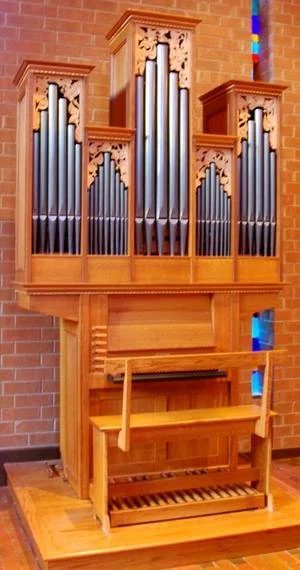
Pipe Organs
The History of Our Organs
Because of the liturgical importance of the organ, the congregation of St. Paul’s determined in 1965 that its new building should provide both the space and the acoustical characteristics needed for a pipe organ. In 1975, the congregation received financial assistance from the Lineberger Foundation and was able to purchase one of seven small organs that John Brombaugh & Co. were building as house organs.
A Lutheran himself, Mr. Brombaugh installed and voiced the one-manual organ in St. Paul’s balcony in 1977. It could play about seventy percent of the repertoire, and in the skilled hands of a succession of part time organists, it served the congregation well. As noted by Fenner Douglass, Duke University Organist and organ consultant, it also created new possibilities in the community: “At Duke one can hear cathedral music… There is need in Durham for a [small] church with the right acoustics and the right organ, where the heritage of Lutheran music may be heard—perhaps for the first time in the entire city or state.”
By 2003, St. Paul’s had hired its first full time minister of music, and the Wolff organ at St. Thomas’ Church in Hanover, New Hampshire was available for purchase. A group of congregation members led by Doug and Fran Whitfield enabled St. Paul’s to purchase it while keeping the muchbeloved Brombaugh instrument. Though the balcony had to be strengthened to accommodate more weight, the existing ceiling lines framed the Wolff organ naturally. Hellmuth Wolff and his associates supervised the installation and voicing of the Whitfield Memorial organ, returning for the dedication service in January, 2004. Today both organs are used regularly for worship and musical performances.
In the early 1970s, the Worship Committee, chaired by Barbara Anderson, led St. Paul’s effort to replace the church’s electronic organ with a more authentic instrument. With matching funds from the Lineberger Foundation, the church placed an order for a small organ with John Brombaugh. That organ, installed in 1976 in the loft at the back of the church, was intended to be temporary – a means of bringing St. Paul’s into the realm of fine music.
Brombaugh Opus 23 - 1977
-
Gedackt 8′ 48 pipes
Principal 4′ 48 pipes
Rohrflöte 4′ 48 pipes
Principal 2′ 48 pipes
Mixtur III 132 pipes -
Subbaβ 16′ 30 pipes
Manual to pedal couplers
Tremulant
6 stops 7 ranks
In 2003, the congregation found an opportunity to purchase a larger organ built by Hellmuth Wolff. Pastor Thomas Colley, Brian Cash, Doug and Fran Whitfield, Diane Archer, Bill and Barbara Anderson, and Gretchen Wilson were among the church members closely involved in the process of acquiring the instrument. In November 2003, the Brombaugh organ was moved to the front of the sanctuary and the Wolff organ (now the Whitfield Memorial organ) was installed in the balcony.
This organ was dedicated on January 11, 2004 in memory of Wilbur Willis Whitfield (1907-1968) and Marjorie Lyon Whitfield (1910-1988).
Wolff & Associés Ltée Opus 17 – 1976
Whitfield Memorial Organ
-
Montre 8′ 56 pipes
Flûte à chemineé 8′ 56 pipes
Prestant 4′ 56 pipes
Doublette 2′ 56 pipes
Bourdon 2′ 56 pipes
Fourniture IV 168 pipes
Trompette 8′ 56 pipes -
Bourdon 8’ 56 pipes
Flûte à chemineé 4’ 56 pipes
Nazard 2 2/3’ 44 pipes
Doublette 2’ 56 pipes
Sesquialtera II 112 pipesCymbale III 138 pipes
Voix Humaine 8’ 56 pipesTremblant doux
-
Soubasse 16’ 30 pipes
Flüte ouverte 8’ 18 pipes
Prestant 4’ 30 pipes
Trombone 16’ 30 pipes
Couplers:
Récit — Grande Orgue
Récit — Pédale
Grande Orgue — Pédale
Zimbelstern
Organ Design
Every organ consists of three essential elements: pipes of unalterable specific pitches, a wind supply, organs have several ranks of pipes, among which the performer chooses according to the tone color desired. A mechanical device called a “stop” enables the player either to call into play or to “stop” the action of a register of pipes.
The free-standing wooden case housing the organ is open at the front and not only serves to protect the pipes but also blends the sound, imparts resonance of its own, and projects the sound of the organ toward the listener. The organ case, designed to be an integral and beautifying feature of the architecture the room, artistically reflects the integral and enhancing role of music in the worship service.
In an organ with tracker action, the direct mechanical link between the keys and the valves admitting air to the pipes assures a number of advantages. Most importantly, tracker action allows the performer, through tactile “feedback,” the precision necessary for subtle and sensitive keyboard articulation and control. Tracker action also minimizes tuning and maintenance requirements and makes for a very durable instrument; tracker organs built three and four centuries ago in European churches are still noted for their beautiful music.

